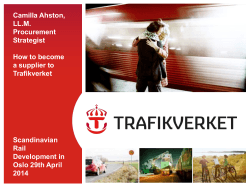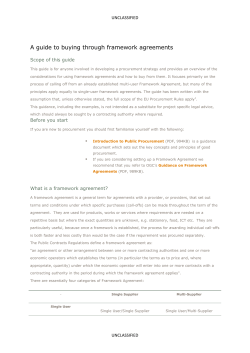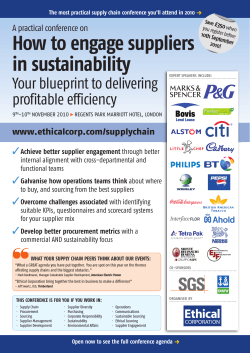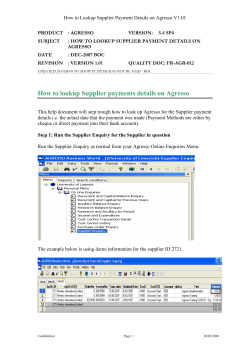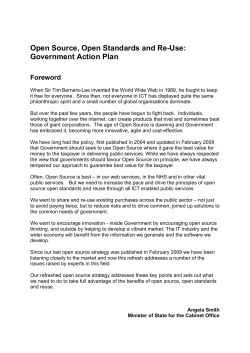
SMM: How-to Guide Dr. Eliza Hixson, WHAT IS SMM? International Centre for
+ Strategic Meetings Management SMM: How-to Guide Dr. Eliza Hixson, International Centre for Research in Events, Tourism and Hospitality at Leeds Metropolitan University This guide offers you insights and case studies from strategic meetings management (SMM) practitioners who can guide you through the SMM process, present its elements and key drivers, explore the reasons for its implementation, introduce the taxonomy created for MPI’s research and take you step-by-step through the program development. WHAT IS SMM? SMM is grounded in a number of concepts that have been discussed for decades in academic literature. For meeting industry professionals, the key components of SMM include supply-chain management, procurement, centralization, value, meeting quality and risk management. As SMM has grown within the sector, meeting industry professionals tend to add data management and meeting design, in particular around return on investment and return on objective. The most widely recognized definition of strategic meetings management was created and published by the Global Business Travel Association (GBTA) and Meeting Professionals International (MPI). It reads as follows. Strategic meetings management is a disciplined approach to managing enterprise-wide meeting and event activities, processes, suppliers and data in order to achieve measurable business objectives that align with the organizations’ strategic goals/vision and deliver value in the form of quantitative savings, risk mitigation and service quality. 2014 | Page 1 SMM Index Maturity Levels The SMM program is working and delivering value; compliance is beginning to gain traction. SMM Support Processes are either non-existent or happening in an ad-hoc fashion The need for SMM support processes is recognized and design of these processes may be starting. Most SMM program basics are in place. The SMM program is working well, and is delivering value that illustrates the tie between the SMM program and overarching business objectives. The SMM program is wording well delivering face value across enterprise. sustainable over time and supported by ongoing and successful efforts for continous improvement. MASTERING EXCELLING OPERATIVE EMERGENT DISCOVERY RANDOM LEVEL ONE LEVEL TWO LEVEL THREE LEVEL FOUR LEVEL FIVE LEVEL SIX WHY ESTABLISH AN SMMP? Although this definition is widely used, existing literature, interviews with leading practitioners and the results of focus group discussions all acknowledge that SMM means different things to different organizations. Often, this is based on the practices and requirements of the individual organization, as not all organizations have the same goals and, therefore, their practices differ. These differences arise from the various perspectives and contexts within which an SMM program (or SMMP) is implemented, and the maturity of that SMMP. In his book on the subject, industry expert Kevin Iwamoto describes six levels of SMM maturity, as follows. At the random level, an organization unsystematically implements SMM practices without being aware of how these practices tie in with SMM. In the discovery stage, the organization learns about SMM and how more practices can be implemented across the organization. At the emergent level, the organization starts adopting and implementing SMM practices in order to get consistency in meeting delivery. At the operative level, the organization has all its SMM operations in place. And in the final two stages, excelling and mastering, the organization focuses on the progress and efficiency at which it implements SMM. In his book, Iwamoto says that maturity is dependent upon the organization’s state of policy, procurement, data analysis and reporting, as well as stakeholder management and meetings technology, among other factors. In contrast, in his writings, Christopher Dwyer adopts an approach that identifies advanced attributes of mature SMMPs in best-in-class organizations, including the following. • Centralizing budgetary control • Improving analytics and reporting • Formalizing sourcing • Improving attendee experience • Enhancing pre- and post-event communication Remember, there is no one-size-fits-all approach to SMM, because not all practices are applicable to every type of organization. Even though SMM may be generally defined the same way, there are elements that are organizationally specific. Dwyer surveyed businesses that have adopted, or are in the process of adopting, an SMMP to ascertain current best-in-class practices using the following four performance criteria to distinguish such organizations. 1.The percentage of meetings/events that meet or exceed goals and objectives 2.The rate of compliance to internal meetings/events polices and guidelines 3.The percentage of meetings and events executed on or below budget 4.The rate of meetings and events spend under management There are a number of key drivers for the growth in SMM adoption. Subject matter expert Mike Malinchok summarizes these drivers under four central headings in his writings. • Visibility • Risk mitigation • Compliance • Cost saving MPI’s own research finds that the key drivers to SMM adoption are increasing savings/avoiding costs (81.7 percent), establishing good communication across the organization (59.8 percent), raising visibility/transparency (56.2 percent), increasing the value of meetings management (55.6 percent) and increasing productivity (54.9 percent). THE SMM TAXONOMY MPI created an SMM Taxonomy based on its systematic literature review and interviews with SMM leaders. Presented here as a table, the taxonomy is split into role (buyer, supplier, planner, consultant) and context (supply-chain management, procurement, centralization of processes, meeting quality/participant experience, executive sponsor). This taxonomy is featured in “Strategic Meetings Management (SMM) Report: SMM Taxonomy, Growth and Future.” It is designed to make it easy to assess what you need to do within the SMM space and what is occurring within best-practice organizations. Identify the role of your organization in the meeting industry and see what you can be doing to align your business with SMM practices. 2014 | Page 2 ROLE OBJECTIVE SUPPLY-CHAIN MANAGEMENT PROCUREMENT PROCESS CENTRALIZATION MEETING QUALITY/ DELEGATE EXPERIENCE EXECUTIVE SPONSORSHIP Buyer Save money Preferred supplier agreements and control Formal sourcing processes reduces steps in purchasing and increases efficiency Visibility of meeting spend, facilitated by data management from budgeting to close out Review of previous events and where savings can be made that do not impact participant experience Review of previous events and where savings can be made that do not impact participant experience Increase Value Close relationship (aware of objectives) Clear procurement processes enable cost and quality criteria to be assessed A meeting master calendar Stated objectives that clearly identify what attendees expect to gain from the experience Organizational guidance for rolling out an SMMP across the whole organization Centralized systems enhance the delegates experience by simplifying Preparedness to back an SMMP during a potentially costly organizational audit and SMM set-up phase SDuty of care to support the delegate and management of meeting cancelation risk in the buyer/ supplier relationship Strong leadership to create buy-in across and between organizations Increase value and save money Increased opportunities for working collaboratively with supply chain partners Manage procurement and respond to RFP Technology systems (meeting requests, RFPs and attendee management) Reduced risk due to known service quality and agreed cancellation fees Supplier Greater visibility to manage demand for meetings Data from central purchasing card Save money Strategic alliances with independents Preferred supplier agreements and SLAs to minimize negotiation Simplified billing process Cost savings passed on to participants when possible to increase attendance and enhance perception of value Understand reasons for securing and supplying cost savings to achieve long-term, stable relationships with buyers Increase Value Consistent service through defined SOPs RFPs that demonstrate the value of relationships with evidence of quality delivery Information sharing Understand target participants in order to support delivery that exceeds expectations Leadership to encourage all staff to understand importance of relationship and to meet and exceed expectations Reducing risk through preferred supplier agreements, SLAs and other forms of managed supplier relationships Simplified processes for securing third party materials Visibility and access to all buyers within an organisation SMM cost savings and value passed on to participants and measured in meeting evaluations If no SMMP, executive leadership to facilitate partnership management with buyer organizations Reduced time in responding to preferred supplier status RFPs Simplified processes for submitting proposals Understand technology to simplify communication and management Cost savings passed on to participants if appropriate Communication and education within the organization Increase Value and save money Planner Centralized approval process Save money On-going contact with buyer Compatible technology platform with buyer Cost savings passed on to buyer Increase Value Client likely to choose a preferred supplier Greater strategic understanding of event objectives Measurement and monitoring processes to support continuous improvement Systems in place to measure ROI and ROO Development and use of existing metrics to measure what success looks like within business and for clients Increase value and save money Development of long term relationships with partners and suppliers Need to manage procurement processes and respond to RFP Need to learn to use technology systems appropriate for your organizational role Request a meeting/ Meeting registration If no SMMP, executive leadership to facilitate partnership management with partner organizations Establishing procedures to manage the risk pertaining to longterm relationships Intermediary Save money Simplified and integrated processes for sourcing suppliers Systematic and centralized procurement processes Centralized systems for processing information Increase Value Enhance communication systems to ensure buyer and supplier are aware of objectives and expectations More robust, consistently updated systems for ensuring quality for sourcing Familiarity with a range of case studies from a variety of industries, so as to advise businesses on SMMP implementation Encourage preferred supplier contracts Know the tech platforms available to clients to assist in SMMP implementation or development Increase value and cost savings Clear understanding of target market and objectives of participants Communication to all levels of organization and with suppliers about SMMP 2014 | Page 3 WHERE TO START? In the SMM Taxonomy, you can see a number of ways to improve the efficiency and effectiveness of managing your meetings. This next section will take you through a step-by-step guide of how to start implementing SMM in your organization. 1. Access Information and Education First and foremost, build your knowledge and understanding of SMM. MPI has developed a number of resources to help you learn more about SMM. The MPI portal can be accessed by the following link: www.mpiweb.org/SMM. Nearly half (46 percent) of respondents to MPI’s research say that education made it easier to develop and implement an SMMP. Alongside education, interviews with industry experts acknowledge that sharing and spreading information is a crucial element of change management. Informing all employees of the purpose of SMM is key to adoption within an organization. Therefore, you need to develop and encourage knowledge across your company. Carole McKellar of HelmsBriscoe says that there’s actually a wide range of different ways that people can start to embrace SMMP. “Of course a huge part of that is communication and education, she says. “Most importantly, success is driven by colleagues talking about their experience, explaining to their peer group how it has been beneficial to them and encouraging people to get on board.” 2. Develop a Business Case Next, build your business case for SMM to establish how it will help your organization and express this to your c-suit managers. Examine your current practices and explore how SMM will enhance your business. When starting her road to SMMP at WellPoint, Cindy Heston gathered and analyzed contracts with suppliers to assess what was occurring within her business. This process took several months as she sought opinions on the broad area of risk management in meetings and travel planning. In this case, it took around six months to move from the initial data collection phase though the consultation process with superiors to the stage where she was able to fully implement her SMM proposals. Heston started off preparing the business-case on procurement grounds, but realized very quickly that the multi-faceted approach she was proposing would in fact tackle the other benefits she was seeking as well. So the initial emphasis on financial savings, though obviously still important, was complemented by the opportunity to take control over many other risk factors affecting the organization. “Once I had built a business case for SMM based on a multifaceted approach, rather than just a procurement approach, it quickly became warmly received within the organization,” she says. “The healthcare reform debate within the U.S. at the time provided the perfect platform for us to reduce the risk in our broader operating environment. The perfect storm happening outside helped us to raise this opportunity at the highest levels, and to get corporate buy-in.” It’s wise to consider the broader organization and sector context within which your company operates, because there may be other, external factors you can address in your interventions that lever additional benefits. Similarly, a case study at IHG found that there were a number of hurdles to creating a business case for SMM. Ingrid Quimby-High from IHG states that from the beginning she had to really make sure that she could quantify a business proposal. Her team conducted months of research to ensure that the need was large enough to justify the investment. Like WellPoint, Quimby-High acknowledges that “there’s a lot of research, pre-work and making sure that you have all the right parties engaged and validation happening across the globe.” 3. Find Executive Sponsorship Upon researching and developing your business case for SMM based on your meeting data, it’s important to gain executive sponsorship. Ideally, this is someone in a position of power who is able to drive and support the implementation of SMM. MPI’s SMM report shows that SMM “champions,” or advocates, encourage adoption. In fact, 72 percent of respondents believe that having a leadership champion makes it easier to adopt an SMMP. The WellPoint case study demonstrates that it’s critical to gain corporate, senior-level support early on by presenting the business rationale that supports your proposals. The importance and the role of executive sponsorship can also be seen in the SMM Taxonomy. In another example, Cisco brought Carolyn Pund on board to drive a strong SMMP at the company. Pund leads the global strategic meetings management team (GSMM), which drives the program. In each Cisco region around the world, there’s a person dedicated to the running of the program, education and adoption. At IHG, the process began with a core group in the meetings department that was responsible for delivering sales strategy, on a global scale, to teams at both regional and hotel levels. Clients, hotel area managers, key hotel franchisees, industry experts and third parties became the pillars in the research and evaluation phases of the process. 4. Get Policies and Procedures in Place Once you have built your business case and have executive sponsorship in place, you need to start implementing the SMM practices that are valuable for your organization. Consider the aims and objectives of your organization and implement practices accordingly. At Cisco, Pund and her co-workers took nearly four years to thoroughly build their global SMMP and the policy around it. By aggregating their travel, finance, contracting, legal and risk management policies, the team produced a robust program document. Says Pund: “With an SMM program and in building the policy you are not an island, you are not just coming in saying ‘this is what is going to happen.’” 5. Review Frequently Implemented SMM Practices MPI’s research shows these Top 5 SMMP practices. • Use documented standard operating procedures (72 percent) • Define objectives with meeting sponsor to align with organization’s objectives (69 percent) • Use preferred supplier agreements (64 percent) • Utilize a master meeting calendar (63 percent) • Use web-based, electronic requests for proposals (55 percent) 2014 | Page 4 These are the practices most commonly implemented in meetings management by organizations around the globe. Additional information on SMM practices can be found on the SMM portal. When you set up your policies and procedures there are a number of aspects to consider. These factors are discussed herein. A.Supply-chain management. In a successful SMM program, all members of the supply-chain work together and make contributions. In their paper on supply chain responsiveness, Daekwan Kim and Ruby Lee say that collaboration with global suppliers is key. Use a limited number of suppliers and choose those who are located around the world. Preferred supplier agreements can be developed with these suppliers so that you get the same level of value and quality regardless of the location of the meeting. Decision scientist Ganesh Vaidyanathan writes that these supply-chain partnerships can provide security, which is highly valuable when trying to achieve consistent quality in meetings. Close relationships within the supply-chain also encourage information sharing, which can be beneficial to the success for all parties involved. Long-term relationships also produce beneficial results, such as leverage to negotiate costs as well as preferential treatment in terms of bookings and cancellation policies. In regard to supply-chain management and the development of business relationships, interviews with experts in the SMM field emphasize the importance of frequent meetings and sharing information with partners. For example, Cisco asks for quarterly reports from its partners, such as hotels, which must be in line with its SMM requirements. Carlson Wagonlit Travel raises the importance of involving stakeholders in one of its papers: “It is important to involve all key stakeholders so that a new, centralized program takes into account their requirements and leverages their expertise.” Having dedicated personnel to manage and liaise with partners is also a key success factor in maintaining relationships. The interviews with practitioners acknowledge that on-going relationships bring various short-term and long-term benefits for both buyers and suppliers. In an Active Network (formerly StarCite) report, the company refers to successful partnerships as a “two-way street” where there is a balance of benefits for partnership participants. Security of supply-chain provides buyers with substantial risk mitigation benefits and confidence in their business continuity planning around potential crises. Suppliers gain a greater level of financial security and an improved ability to plan strategically. From a supplier perspective, IHG works seamlessly with client SMMPs so that it can solve needs on an individual basis, including all levels of programs. It developed a technology platform that offers a plethora of tools to ensure that hotel staff can support all clients. In addition, the strategy had to be adaptable to correspond to hotels across the globe. B.Procurement. Relating to supply-chain management is the area of procurement. According to a paper by Dr. Peter Naudé, purchasing can take three forms: re-buy, modified re-buy and new buy. Each of these scenarios impacts the steps in the procurement process. For example, a new buy requires information searching and identification of the most appropriate service or good. These steps are skipped in modified re-buy or re-buy situations because the supplier has been identified and there is an established relationship between the two parties. SMM places itself within the re-buy position, whereby contracts between buyers and suppliers are established in the form of preferred supplier agreements. Therefore, says travel company AdVito, an SMMP can streamline sourcing and contracting. This increases the reliability of procurement because both parties are already familiar with the expectations and requirements of the other party. It can also create greater efficiency in the procurement process. In a Maxvantage paper, the writers suggest that SMM programs are often put through the formal sourcing process in order to apply strong procurement principles, which includes leveraging the total meeting expenditure volume of the company. Examples of procurement principles within the meeting sector include the use of preferred hotel agreements. According to BCD Incentives, a preferred hotel program drives SMM success, with buyers able to streamline the purchasing process due to existing contracts and relationships with the supplier. According to a GBTA Foundation paper, preferred hotel or master service agreements (MSAs) with suppliers can also assist the procurement process, with timeframes for delivery, meeting requirements and responsibilities contractually agreed upon prior to the meeting. This process is also advantageous for suppliers because they gain greater clarity on the requirements and expectations of their clients. C.Centralized processes. In his book, The Company of the Future, Frances Cairncross states that centralization is required to achieve speed, productivity and coherence. In an online column, Paul Colston agrees, advocating that more centralization within the meeting sector will make SMMPs efficient and successful. Examples include master meetings calendars, registration systems and centralized approval processes. The first phase of MPI’s SMM study identifies that practices such as these increase consistency and efficiency. Moreover, adopting these practices can result in cost savings, reduced liability and increased standards of delivery. WellPoint established that a culture of openness and a willingness among different teams and business units to share information on budgets, contracts, activities and concerns is important for consistency and compliance. Therefore, a platform to share information and centralize processes is an important step. D.Implement support technologies. Central technology systems can be set in place to manage many elements of a meeting, including planning, budgeting, purchasing, attendance, payments and measurement, according to SMM expert Kevin Iwamoto. StarCite has determined that travel departments often have centralized systems such as this, whereas the meeting sector often uses multiple tools. Therefore, there is scope for meetings to develop and co-locate these processes. Centralized processes also make it easier to construct reports on the outcomes of the meetings held within an organization, Maxvantage found. The MPI focus group conducted at EIBTM 2012 in Barcelona especially related to this point, with experts saying that reports produce a wealth of information—however careful analysis needs to be applied in order to transfer this from data to business intelligence. WellPoint uses data software as a tool to monitor all expenditure from travel, venue, food and beverage, audiovisual and accommodation, for instance. The organization piloted three 2014 | Page 5 different products over the course of a year before reverting to the technology tool they had been originally using. There are a number of software providers that are available, so it is a case of trialling and finding out what system works for you. Think about what information you need to capture and what you will use your technology platform for. Become familiar with your requirements so you can analyze which software is most appropriate for you. For example, to capture data around its meetings, Cisco has a robust custom-built portal. Team members send a request for all meetings over a cost threshold to be put on the portal. Each meeting goes through a submission process and is then put forward for logistical planning, website build and attendee registration and payment. The use of the portal ensures that data is standardized and comprehensive. This helps to ensure that the data are captured and can be analyzed. FACTORS INFLUENCING SMM ADOPTION The MPI literature search, interviews and survey responses indicate that geographical spread and organizational culture and size can impact the adoption of practices across a company. Positive attitude to change and ability to mandate were two factors that help drive adoption in an organization. 1. Geographical Spread AdVito found several factors that constrain the implementation of an SMMP in a global context, including language, currency and exchange, cultural issues and global suppliers. Therefore, global businesses based in the U.S. that want to spread their programs to other parts of the world could face difficulties. Maxvantage went so far as to create standard operating procedures (SOPs) for each country to help companies overcome some of these global challenges. 2. Organizational Structure and Size Organizational cultures also differ; some may be more resistant to change than others. Maxvantage found that these differences can be based on corporate culture and also the culture of the country AdVito (2007). “The View from the Other Side of the Pond: Hidden challenges and intelligent solutions to global meetings management consolidation,” AdVito, Dallas. BCD Meetings & Incentives (2010). “Bottom-line savings with SMM,” http://www.bcdmi.com/documents/Valuethroughoutsourcing.pdf. in which an organization is operating. The geographical differences raise an issue for U.S.-based companies that want to spread their SMMPs to other locations around the world. In this case, listen and collaborate with employees so that they are aware of the reasons to implement an SMMP and how it can benefit them. As stated before, adoption of an SMMP requires executive sponsorship and SMM champions. Educating employees about the value of adopting the system can be a vital element to its success. Mike Malinchok suggests focusing on both cost and value-add as reasons to implement an SMMP. Organizations that focus purely on cost may experience some push back and less development of their SMMPs because the value levels have not been considered. 3. Attitude to Change and Ability to Mandate Change management is a recurring theme in the interviews with practitioners, and the MPI research aimed to explore this further and identify how important this factor is for SMM adoption. More than half (55 percent) of respondents believe that the ability to mandate makes it easier to implement SMM. And 52 percent of respondents believe that a positive attitude to change also makes it easier to start an SMMP. Take-Aways • Heighten the visibility of current meetings spend by conducting an organization-wide audit of who currently organizes meetings and their associated costs. • Show how meeting objectives can be obtained through consolidation. • In association with human resources and staff travel, show how geographical consolidation of disparate meetings across the organization can reduce costs, improve risk mitigation and enhance productivity. GBTA Foundation (2013). “Guide to Strategic Meetings Management RFI or RFP,” GBTA, Chicago. Iwamoto, K. (2011). Strategic Meetings Management Handbook: From theory to practice, Easton Studio Press. Cairncross, F. (2002). The Company of the Future, Profile Books, London. Kim, D., & Lee, R. P. (2010). “Systems Collaboration and Strategic Collaboration: Their Impacts on Supply Chain Responsiveness and Market Performance,” Decision Sciences, 41(4), 955-981. Carlson Wagonlit (2010). “Improving strategic meetings management, piece by piece.” Malinchok, M. “Strategic Meetings Management (SMM): The four key value drivers,” S2K Performance Coaching. Colston, P. (2012). “SMMP: The word on the block,” Conference News Magazine, http://www.conference-news.co.uk/feature/2012/09/21/ SMMP-the-word-on-the-block/150. Naudé, P. (2012). “Organisational buyer behaviour,” video resource, http://hstalks.com/main/view_talk.php?t=2182&r=633&c=250. Degnan, Manning, C. D. and Savelli, C. (2010) “Strategic Meetings Management: The next cost savings opportunity,” Maxvantage. Dwyer, C.J. (2012). “Strategic Meetings Management: A handbook of emerging strategies for the next generation of meetings and events management,” Aberdeen Group. Dwyer, C.J. (2011). “Strategic Meetings Management: A view into the best-in-class strategic meetings management program,” Aberdeen Group. StarCite (2009). “Partner Perfect: Strategic sourcing remains key to effective meetings management,” StarCite, Philadelphia. StarCite (2009). “Integrating Corporate Travel, Procurement and Meetings Management: A best practice roadmap to strategic meetings management success,” StarCite, Philadelphia. Vaidyanathan, G. (2012). “Does security impact e-procurement performance? Testing a model of direct and moderated effects,” Decision Sciences, 43(3), 437-458. 2014 | Page 6 Meeting Professionals International (MPI) Foundation is passionately committed to bringing vision and prosperity to the meeting and event community worldwide by investing in results-oriented initiatives and programs that shape the future and bring success to the industry. MPI is the largest and most vibrant global meeting and event industry association, comprised of approximately 20,000 members belonging to 71 chapters and clubs worldwide. For more information, visit www.mpifoundation.org. Lanyon is the leading provider of cloud-based software for the Meetings and Events industry and Transient Hotel Programs. Leveraging more than 40 years of industry experience, the Company enables thousands of associations, Small to Mid-sized Businesses and enterprise organizations around the world to drive efficiency, engagement and growth from their meetings, events and travel investments. Clients include 70% of the Fortune 500, 80% of the Business Travel News Corporate Travel 100, and more than 100,000 hospitality suppliers. For more information, visit www.lanyon.com. Gaylord Hotels, a world-renowned leader in resort experiences, has recently joined the Marriott portfolio of brands to offer guests breathtaking vacation and convention options. From the scenic banks of the Potomac in Washington, D.C. to the lively heart of Music City in Nashville, Gaylord Hotels celebrate the heritage of their destinations. Fueled by the brand’s hallmark “Everything in one place” concept, each Gaylord Hotels resort blends magnificent settings, luxurious rooms and world-class entertainment to delight every guest with a truly enchanting getaway. Visit www.marriott. com/gaylord-hotels/travel.mi. About MPI Meeting Professionals International (MPI) is the largest and most vibrant global meeting and event industry association. The organization helps its members thrive by building human connections through knowledge and ideas, relationships, and marketplaces. MPI membership is comprised of approximately 20,000 members belonging to 71 chapters and clubs worldwide. For additional information or to join, visit www.mpiweb.org. Meeting Professionals International Headquarters 3030 LBJ Freeway, Suite 1700 Dallas, TX 75234-2759 tel +1-972-702-3000 fax +1-972-702-3089 Canada 6519-B Mississauga Road Mississauga, Ontario L5N 1A6 Canada tel +905-286-4807 fax +905-567-7191 MPI Staff Marj Atkinson, Research Manager Javier Adame, Graphic Designer Jessie States, Editor Called “baseball’s perfect address,” AT&T Park offers sweeping views of the city and bay, modern amentities, a top-rated event management team and a virtually unlimited array of creative options. It’s your perfect address for a unique and successful event, no matter what your objectives. Visit giants.mlb.com/sf/ballpark. AVT Event Technologies Inc. is one of the leading technology providers of innovative in-house audiovisual, staging, and production services at hotels and resorts nationwide. With on-site expertise in next generation technologies ranging from Internet provisioning to full event production, AVT Event Technologies represents a higher standard in “one-stop shopping” for event and technology needs in a hospitality environment. Based in Arlington Heights, Ill., AVT Event Technologies has offices in 47 cities across the US and is a division of Freeman, a premier provider of integrated experiential marketing solutions. For more information, visit www.avt.com. MCI is a globally integrated association-, communication- and event management company. Our combined expertise enables us to offer strategy, creativity and execution in the fields of association management, performance improvement, professional congress organization (PCO) and meetings and events. Visit www.mci-group.com. © 2013, Meeting Professionals International. All Rights Reserved
© Copyright 2025





